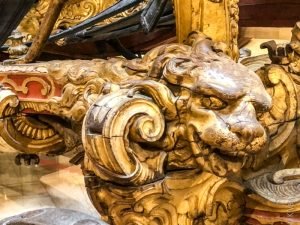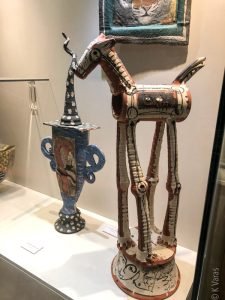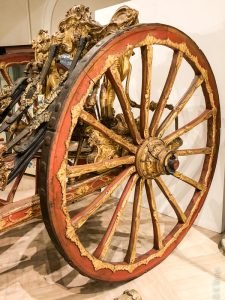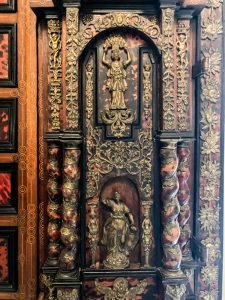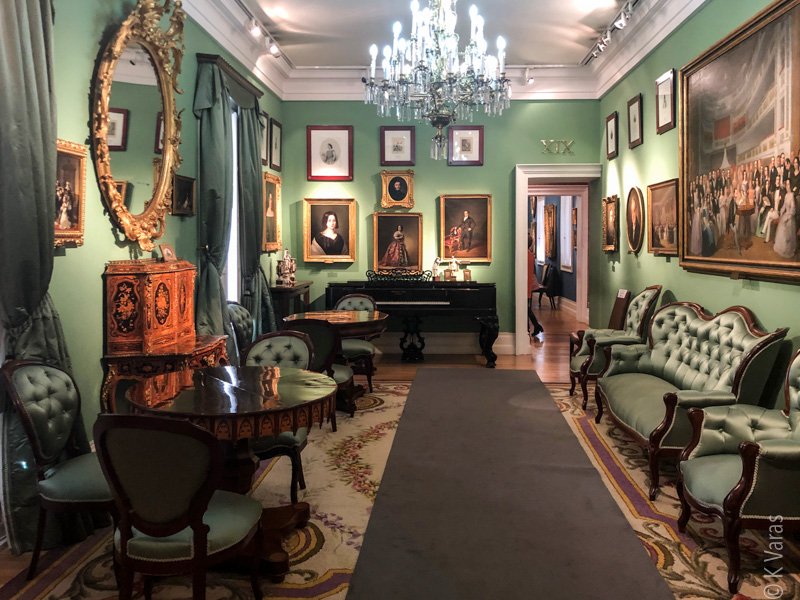
Museu Nacional de Ceràmica
There are some buildings (many of them by Gaudí) that make you want to go back to look at them over and over and over again. Museu Nacional de Ceràmica i de les Arts Sumptuàries “Gonzàlez Martí” (Gonzàlez Martí National Museum of Ceramics and Decorative Arts) isn’t by Gaudí but it is so stunning that the only way you can look at it is with your mouth hanging open. And you want to go back again and again. I am not kidding. I already gave you a glimpse of this beauty earlier … now is the time to check it out inside!
After a couple of lazy days (again), I needed some city time so I took the tram and metro and made my way from the Xativa subway station towards Plaça de l’Ajuntament to take a good look at it during the day. Once there I noticed all the flower stands circling the main plaza in front of the Valencia City Hall building (Ajuntament de València) … Remember that a flower market used to be located here before the rebuilding of the plaza many years ago. Seeing all the flowers made me a bit homesick: it’s going to be a while before I take another flower arrangement class at Poppies or make something at home. Living out of two suitcases definitely has its drawbacks, especially when it comes to certain artistic activities.

After a few minutes of people watching, I made my way east from the plaza towards the Ceramics Museum – today’s chosen destination. This time I came around from the other side of the building and was once again struck by its beautiful originality. The massive doors were open this time and I made my way inside. After paying a “hefty” entry fee of €3, I started the journey back in time. Until then I had not realized that this is not just a museum of ceramics, it is also a beautifully preserved palace dating back to late XIV century!

The building was constructed by the Rabassa Perellós family starting with Don Francisco Perellós, a merchant who not only made lots of money back in the XV century, but also married well. His descendants eventually received the title of Marquis from King Carlos II in 1699, and now the palace is called Palacio del Marqués de Dos Aguas (or Palau del Marqués de Dosaigües). The original building was first erected early in the XIV century as depicted on the famous Plan of València drawn by Father Tosca (more on this coming soon, I promise). In the XV century the rich Gothic exterior facades and splendid interiors were added. In the XVIII century a major renovation was undertaken by the 3rd Marquis of Dos Aguas, mostly to show off, I will presume, and a great job he did at that. As far as I can find out, the exterior we see now originated from this time, and it was designed by Hipólito Rovira, who, together with his craftsmen, gave the building a spectacularly Rococo finish, while the interior of the palace is more Baroque in style, with classic mirrors, bold colours, and grotesque designs, trompe l’oeil paintings and frescoes. (I love how much I’m learning about architecture though I doubt I could pass a test on this yet 🙃.)
As I entered the main part of the palace, the first thing I saw were the two carriages on display. I’ve always loved carriages, partly because of the terribly romantic notion of them (I bet you didn’t take me for a romantic, eh?) and partly because I believe one of my great-grandparents was a carriage-maker and made some fancy ones. I come from a long line of craftspeople, at least on one side of the family, and maybe that’s why I appreciate craftsmanship as much as I do. These two were definitely examples of very fine craftsmanship.

Since this IS a museum of Ceramics and Decorative Arts, there were also display cabinets throughout the whole palace, some as permanent exhibits and some temporary. In the Gallery, I grouped the ceramics and decorative arts together and the palace photos separately, as much as possible. I made my way up the glorious staircase to the first floor, the main living space. Here I went through a number of rooms, including:
- Famous People Room: a room with various important men looking down from above (portraits);
- Inner Patio: now containing various display cases as well as a light well for the lower level; there is a glass roof over the patio now though I suspect originally this would have been open to the fresh air;
- Luminary Room: full of mirrors and ingenious light fixtures;
- Chinese Room: a small sitting room with an exquisite table and china cabinets;
- Dining Room;
- Smoking Room: a somber, dark room with a gorgeous arras and black furniture, to hide smoke damage, I guess;
- Prayer Room: for those times you need to pray but can’t get to the church around the corner; and
- Pinazos’ Room: a large space with massive paintings on the walls that leads to the private part of the house and also stairs to the third floor.

At this point I was directed up the stairs where the many rooms dedicated to the exhibition of the ceramics collection is located, originally donated by Manuel Gonzàlez Martí (hence the name of the museum!). The pieces here span five centuries of art and design, as well as worldwide geographic origins: from prehistoric New World to Picasso and fancy China to modern art.
Originally, the rooms on this floor were private family chambers, though now there is no sign of that at all. However, the last room I saw was a kitchen, which surprised me a lot since I know that kitchens in palaces are never on an upper floor but rather on the main floor or, more commonly, in the basement. Clearly this kitchen was not the original one, if anything it looked like a scaled-down model. I have since found out that this kitchen was created by the fellow Gonzàlez Martí, and it is a reproduction of a typical Valencian kitchen. Manuel González Martí was an interesting figure himself: a bourgeois lawyer who preferred to work as a cartoonist and ceramist, in the end becoming a patron of the arts. So much better than a lawyer then 😉.

I should add that, as is so common these days, I was the only visitor perusing the place, and all of a sudden I noticed that I was being followed by a number of the museum staff and security. Once they caught my attention I was told to leave the museum immediately because it was closing. I checked my watch and it was only 1:30pm–I knew the place was closing at 2pm and reopening at 4pm–so I thought I still had time to finish; I really didn’t think there was much left. No amount of arguing bought me any more viewing time, however, but I was told that my ticket was valid the whole day and that I could come back after 4pm to finish the tour. Disappointed to be kicked out with so little still unseen, I left to look for a meal. Fortunately for me, I found a great little Italian place nearby and had an amazing Hunter’s Tagliatelle pasta. It had started to rain a bit, but after hanging out a little at the restaurant and wasting more time at the Corte Ingles browsing the bookstore, I went back to the museum only to realize I had somehow misplaced my ticket and could not get back inside! Very disappointed I vowed to return, probably with Ewa, to see it once more. Whether I like it or not this is a place I need to come back to, even if it’s just to see the rest of the rooms!





